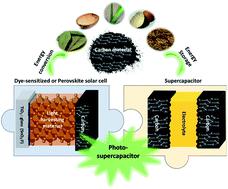当前位置:
X-MOL 学术
›
Sustain. Energy Fuels
›
论文详情
Our official English website, www.x-mol.net, welcomes your
feedback! (Note: you will need to create a separate account there.)
Biomass-derived carbon electrodes for supercapacitors and hybrid solar cells: towards sustainable photo-supercapacitors
Sustainable Energy & Fuels ( IF 5.0 ) Pub Date : 2021-07-29 , DOI: 10.1039/d1se00954k Nilanka M. Keppetipola 1 , Céline Olivier 1 , Thierry Toupance 1 , Ludmila Cojocaru 1
Sustainable Energy & Fuels ( IF 5.0 ) Pub Date : 2021-07-29 , DOI: 10.1039/d1se00954k Nilanka M. Keppetipola 1 , Céline Olivier 1 , Thierry Toupance 1 , Ludmila Cojocaru 1
Affiliation

|
Due to their outstanding electrochemical properties, electrical conductivity, flexibility, and low-cost, carbon materials open up new opportunities for the design of compact devices with a wide variety of potential applications. Biomass renewable resources for carbon material preparation have attracted huge attention in the last few years due to their widespread availability, low-cost processability and high-performance of the resulting porous carbons for sustainable technological applications. For example, the porosity and morphology of carbon materials, which can be tuned by different activation methods, govern the ion diffusion rate during supercapacitor charge/discharge processes. On the other hand, carbon electrodes have been applied as electrodes for dye-sensitized and perovskite solar cells, thanks to their low fabrication cost, compact structure, and optimized interfaces, which play a key role in the charge collection and stability of the devices. Moreover, due to the possibility of using carbon electrodes for storage and conversion devices, efficient methods to harvest and store energy in one single device are crucial for technological advancement and the energy transition process. This contribution aims to review the advances made in the use of carbon materials obtained from biomass sources as electrodes for storage and energy conversion devices, and the future application of shared and/or distinct carbon electrodes for the development of integrated power packs including supercapacitors and dye-sensitized or perovskite solar cells. The storage properties of supercapacitors are discussed in terms of the textural characteristics of biomass-derived activated carbons while the photovoltaic parameters of solar cells based on bio-sourced carbons are compared with those of devices using conventional metal-based electrodes. Finally, special emphasis is placed on the energy conversion–storage efficiencies of solar cell-supercapacitor integrated devices.
中文翻译:

用于超级电容器和混合太阳能电池的生物质衍生碳电极:迈向可持续的光超级电容器
由于其出色的电化学性能、导电性、柔韧性和低成本,碳材料为具有广泛潜在应用的紧凑型设备的设计开辟了新的机会。用于碳材料制备的生物质可再生资源由于其广泛的可用性、低成本的可加工性和用于可持续技术应用的多孔碳的高性能在过去几年中引起了极大的关注。例如,碳材料的孔隙率和形态可以通过不同的激活方法进行调整,在超级电容器充电/放电过程中控制离子扩散速率。另一方面,碳电极由于其制造成本低,已被用作染料敏化和钙钛矿太阳能电池的电极,紧凑的结构和优化的接口,对器件的电荷收集和稳定性起着关键作用。此外,由于可以将碳电极用于存储和转换设备,因此在单个设备中收集和存储能量的有效方法对于技术进步和能源转换过程至关重要。该贡献旨在回顾使用从生物质来源获得的碳材料作为存储和能量转换设备电极的进展,以及共享和/或不同碳电极在开发集成电源组(包括超级电容器和染料)中的未来应用-敏化或钙钛矿太阳能电池。根据生物质衍生活性炭的质地特性讨论了超级电容器的存储特性,同时将基于生物源碳的太阳能电池的光伏参数与使用传统金属基电极的设备的光伏参数进行了比较。最后,特别强调太阳能电池-超级电容器集成器件的能量转换-存储效率。
更新日期:2021-08-25
中文翻译:

用于超级电容器和混合太阳能电池的生物质衍生碳电极:迈向可持续的光超级电容器
由于其出色的电化学性能、导电性、柔韧性和低成本,碳材料为具有广泛潜在应用的紧凑型设备的设计开辟了新的机会。用于碳材料制备的生物质可再生资源由于其广泛的可用性、低成本的可加工性和用于可持续技术应用的多孔碳的高性能在过去几年中引起了极大的关注。例如,碳材料的孔隙率和形态可以通过不同的激活方法进行调整,在超级电容器充电/放电过程中控制离子扩散速率。另一方面,碳电极由于其制造成本低,已被用作染料敏化和钙钛矿太阳能电池的电极,紧凑的结构和优化的接口,对器件的电荷收集和稳定性起着关键作用。此外,由于可以将碳电极用于存储和转换设备,因此在单个设备中收集和存储能量的有效方法对于技术进步和能源转换过程至关重要。该贡献旨在回顾使用从生物质来源获得的碳材料作为存储和能量转换设备电极的进展,以及共享和/或不同碳电极在开发集成电源组(包括超级电容器和染料)中的未来应用-敏化或钙钛矿太阳能电池。根据生物质衍生活性炭的质地特性讨论了超级电容器的存储特性,同时将基于生物源碳的太阳能电池的光伏参数与使用传统金属基电极的设备的光伏参数进行了比较。最后,特别强调太阳能电池-超级电容器集成器件的能量转换-存储效率。











































 京公网安备 11010802027423号
京公网安备 11010802027423号